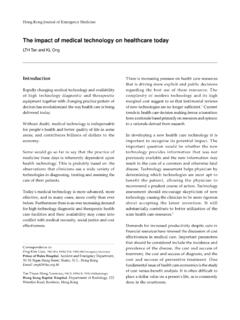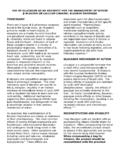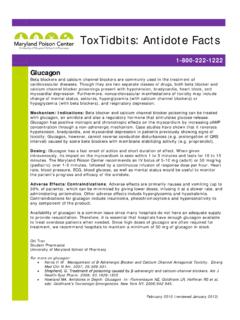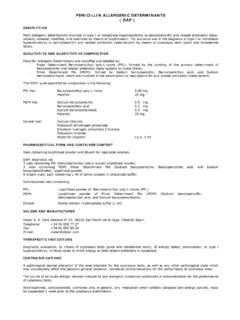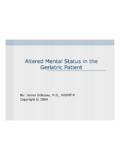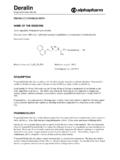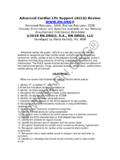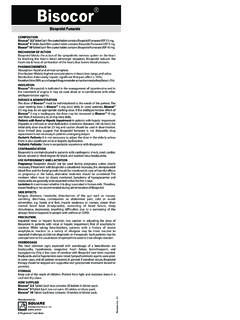Transcription of The use of glucagon and other antidotes in a case …
1 Hong Kong Journal of Emergency MedicineThe use of glucagon and other antidotes in a case of beta-blocker andcalcium channel blocker overdose HT Fung , CH Lai , OF Wong , KK Lam , CW Kam We report a case of metoprolol and nifedipine overdose complicated by hypotension which responded tointravenous boluses of calcium chloride and glucagon . The blood pressure was subsequently stabilised bycontinuous glucagon infusion with the aid of an insulin-dextrose drip. The discussion is focused on the roleof antidotes and catecholamine inotropes in the management of beta-blocker and calcium channel blockerpoisoning. (Hong Kong 2007;14:113-118) Keywords: Adrenergic beta-antagonists, antidotes , calcium channel blockers , glucagon , overdose Correspondence to:Fung Hin Tat, MRCP, FRCSEd, FHKAM(Emergency Medicine)Tuen Mun Hospital, Accident & Emergency Department, TsingChung Koon Road, Tuen Mun, , Hong KongEmail: Cing Hon, MBBS, MRCSEd, FHKAM(Emergency Medicine)Wong Oi Fung, MBChB, MRCSEdLam Ka Keung, MBBS, MRCSEd, FHKAM(Emergency Medicine)Kam Chak Wah, MRCP, FRCSEd, FHKAM(Emergency Medicine)of 226 msec.
2 Two hundred millilitres of normal salinewere administered as intravenous bolus but the BP 30minutes later was 75/57 mmHg. After receivingintravenous glucagon 3 mg over 5 minutes, her BPincreased to 88/63 mmHg. With a second dose ofglucagon at 6 mg and 10 ml of 10% calcium chlorideadministered 17 minutes later, the BP rose to 107/78mmHg and she vomited twice. Calcium chloride 1 g wasrepeated and glucagon infusion at 9 mg/h wascommenced. Actrapid HM 6 IU/h based on an estimatedbody weight of 60 kg and dextrose 6 g/h weresubsequently added in view of a BP of 92/63 mmHg atthe end of the first hour of glucagon infusion. The bloodpressure at one hour after placing on insulin-dextrosealone was 95/57 mmHg and then glucagon infusion at9 mg/h was reintroduced after the arrival of the pharmacystock.
3 One hour post- glucagon resumption the BP was114/79 mmHg. In the rest of the ED stay, the BP readingswere all above 100/60 mmHg, ranging from 110/70 to120/80 mmHg most of the time, except for one occasionof 97/61 mmHg half-an-hour after an inadvertentinterruption of the glucagon 45-year-old female with hypertension, diabetes mellitus,hyperlipidaemia and renal impairment was brought tothe emergency department (ED) in September 2006 fordrowsiness after drug overdose . The history obtained fromthe patient and her sister suggested ingestion of 60 tabletsof metoprolol, slow-release nifedipine and prazosin 10hours ago. She had a Glasgow Coma Scale (GCS) of14/15, blood pressure (BP) 79/54 mmHg, pulse rate55/min, respiratory rate 18/min, SpO2 98% on room airand blood glucose mmol/L.
4 The ECG showed sinusbradycardia and first-degree heart block with PR intervalHong Kong j. emerg. med. Vol. 14(2) Apr 2007114 Her GCS improved to 15/15 eight hours after the EDattendance. The pulse rate was stable between 60 and70/min. The PR interval, 226 ms on arrival, reached apeak of 238 ms (Figure 1) 7 hours later but wasnormalised to 184 ms 25 hours post-attendance. Therewas no hypoglycaemic episode and the blood glucoseduring insulin therapy varied between 7 and 17 hour after the two doses of calcium chloride, theserum albumin adjusted calcium was mmol/L,falling spontaneously to mmol/L after 18 renal function was deranged with urea mmol/Land creatinine 173 umol/L on presentation.
5 Thecreatinine was corrected 18 hours later to 118 umol/L,identical to that four months glucagon and insulin dextrose infusions weregradually tapered down in response to thehaemodynamic improvement. The duration ofglucagon infusion was 20 hours and the cumulativedose inclusive of the first two boluses was 109 hyperinsulinaemic euglycaemia therapy wastapered off after 23 hours. other drug treatmentsundertaken were 1 L of normal saline over 23 hoursand 4 doses of 50 g activated charcoal. The treatmentsoffered were summarised in Table 1. After regainingfull consciousness, she admitted that she had taken 30tablets of hypnotics and other medications with anestimated amount of 4,200 mg of metoprolol,1,120 mg of slow-release nifedipine, 84 mg of prazosin,Table 1.
6 Summary of the treatment given to the patientTreatmentTotal doseDurationGlucagon109 mg (including 9 mg of loading dose)20 hoursCalcium26 mmol (in 2 doses)Dextrose-insulin dripMaximum rate of Actrapid HM 6 IU/h and dextrose 6 g/h23 hoursNormal saline1 L23 hoursActivated charcoal50 g for 4 dosesFigure 1. ECG showing sinus bradycardia and first-degree heart et and calcium channel blocker overdose1152,240 mg of gliclazide and 280 mg of fluvastatin. Shedeveloped dizziness about one hour later but shemanaged to go home for sleep. Awareness of thesurroundings was present only after ED arrival. Shewas discharged on the next day from the ED followingpsychiatric overdose of beta- blockers , metoprolol is second topropranolol in the occurrence of cardiovascularmorbidity which is aggravated by cardiovascular co-ingestants, primarily calcium channel blockers , cyclicantidepressants and The differentreceptor selectivity in the heart and vasculature ofdifferent calcium channel blockers may be lost in theoverdose situation.
7 Hypotension, dysrhythmia andsinus node depression develop equally commonly inpoisoning of verapamil, diltiazem and nifedipine butverapamil accounts for more frequent and more severeatrioventricular node conduction overdose ofprazosin, a post-synaptic alpha-1-adrenergic receptorantagonist, causes hypotension and ,4 Thebradycardia in our case could be ascribed to metoprololwith or without nifedipine whereas the first-degreeatrioventricular block was more likely due tometoprolol. Onset of symptoms and signs may helpdifferentiate metoprolol from slow-release nifedipinepoisoning as the former usually has an earlier the early dizziness in this patient may beexplained by both the hypnotic effect and themetoprolol-induced hypoperfusion.
8 Moreover thehaemodynamic status was unknown in the many hoursbefore the ED calcium channel blockers and beta-blockershinder calcium entry through the L-type calciumchannels in myocytes and vascular smooth muscle administration improves BP and cardiacconduction in calcium channel blocker was reported to restore palpable pulses in a case ofatenolol-induced electromechanical Adose response relationship probably exists but theoptimal dose has not been determined ,6 Concerning possible detrimental effects of post-calcium administration hypercalcaemia in poisoningsettings, there is a paucity of experience so far. Ourcase's serum calcium level was mmol/L after26 mmol of intravenous calcium but there were noobvious symptoms and signs of hypercalcaemia.
9 Thehypercalcaemia of mmol/L in a verapamil-poisonedpatient treated with 30 g of calcium gluconate droppedto normal after four days with no binding of glucagon on myocardial glucagonreceptor, as demonstrated by 125I- glucagon studies,bypasses the beta-adrenergic receptor and increases theintracellular calcium available for actin-myosincoupling through Gs protein mediated adenylatecyclase activation, phosphodiesterase inhibition andarachidonic acid The optimal chronotropicaction of glucagon relies on normal serum calcium levelaccording to rat The post-calcium therapyhypercalcaemia in human case reports wasinconsequential, but attenuation on glucagon 's action,if any, remains to be animal models of propranolol overdose , glucagonconsistently augments the heart rate but the benefitson BP, cardiac output and survival rate are less appears to increase the heart rate and cardiacoutput and circumvent the atrioventricular block inanimals overdosed with calcium channel it does not significantly affect the meanarterial pressure and mortality rate.
10 The implicationof many of these animal studies was limited byinsufficient glucagon dosage, unblinded design andsmall number of Studies on the role ofglucagon in human poisoning are lacking. Glucagonwas noticed reversing hypotension within two minutesin a nifedipine poisoned patient failing calciumchloride glucagon requirement of 108 mgover 33 hours and 120 mg over 24 hours had beenobserved in two cases poisoned by nifedipine andpropranolol ,15 In a case of mixedamlodipine and atenolol overdose , the patientrecovered fully after receiving 264 mg of glucagon in52 The favourable outcome in these casescould not be completely attributed to glucagon becauseof the co-administration of other inotropes.
